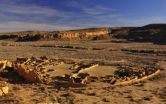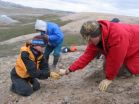(Press-News.org) Scientists have sketched out one of the greatest baby booms in North American history, a centuries-long "growth blip" among southwestern Native Americans between 500 and 1300 A.D.
It was a time when the early features of civilization--including farming and food storage--had matured to a level where birth rates likely "exceeded the highest in the world today," the researchers report in this week's issue of the journal Proceedings of the National Academy of Sciences.
Then a crash followed, says Tim Kohler, an anthropologist at Washington State University (WSU), offering a warning sign to the modern world about the dangers of overpopulation.
"We can learn lessons from these people," says Kohler, who co-authored the paper with WSU researcher Kelsey Reese.
The study looks at a century's worth of data on thousands of human remains found at hundreds of sites across the Four Corners region of the Southwest.
"This research reconstructed the complexity of human population birth rate change and demographic variability linked with the introduction of agriculture in the Southwest U.S.," says Alan Tessier, acting deputy division director in the National Science Foundation's (NSF) Directorate for Biological Sciences, which supported the research through NSF's Dynamics of Coupled Natural and Human Systems (CNH) Program.
"It illustrates the coupling and feedbacks between human societies and their environment."
CNH is also co-funded by NSF's Directorates for Geosciences and Social, Behavioral & Economic Sciences.
While many of the remains studied have been repatriated, the data let Kohler assemble a detailed chronology of the region's Neolithic Demographic Transition, in which stone tools reflect an agricultural transition from cutting meat to pounding grain.
"It's the first step toward all the trappings of civilization that we currently see," says Kohler.
Maize, which we know as corn, was grown in the region as early as 2000 B.C.
At first, populations were slow to respond, probably because of low productivity, says Kohler. But by 400 B.C., he says, the crop provided 80 percent of the region's calories.
Crude birth rates--the number of newborns per 1,000 people per year--were by then on the rise, mounting steadily until about 500 A.D.
The growth varied across the region.
People in the Sonoran Desert and Tonto Basin, in what is today Arizona, were more culturally advanced, with irrigation, ball courts, and eventually elevated platform mounds and compounds housing elite families.
Yet birth rates were higher among people to the North and East, in the San Juan Basin and northern San Juan regions of Northwest New Mexico and Southwest Colorado.
Kohler said that the Sonoran and Tonto people eventually would have had difficulty finding new farming opportunities for many children, since corn farming required irrigation. Water from canals also may have carried harmful protozoa, bacteria and viruses.
But groups to the Northeast would have been able to expand maize production into new areas as their populations grew.
Around 900 A.D., populations remained high but birth rates began to fluctuate.
The mid-1100s saw one of the largest known droughts in the Southwest. The region likely hit its carrying capacity.
From the mid-1000s to 1280, by which time all the farmers had left, conflicts raged across the northern Southwest but birth rates remained high.
"They didn't slow down," says Kohler. "Birth rates were expanding right up to the depopulation. Why not limit growth? Maybe groups needed to be big to protect their villages and fields.
"It was a trap, however."
The northern Southwest had as many as 40,000 people in the mid-1200s, but within 30 years it was empty, leaving a mystery.
Perhaps the population had grown too large to feed itself as the climate deteriorated. Then as people began to leave, that may have made it harder to maintain the social unity needed for defense and new infrastructure, says Kohler.
Whatever the reason, he says, the ancient Puebloans show that population growth has clear consequences.
INFORMATION:
Scientists chart a baby boom -- in southwestern Native-Americans from 500 to 1300 A.D.
Southwest US experience holds lesson in over-population
2014-06-30
ELSE PRESS RELEASES FROM THIS DATE:
Lead in kids' blood linked with behavioral and emotional problems
2014-06-30
Emotional and behavioral problems show up even with low exposure to lead, and as blood lead levels increase in children, so do the problems, according to research funded by the National Institute of Environmental Health Sciences (NIEHS), part of the National Institutes of Health. The results were published online June 30 in the journal JAMA Pediatrics.
"This research focused on lower blood lead levels than most other studies and adds more evidence that there is no safe lead level," explained NIEHS Health Scientist Administrator Kimberly Gray, Ph.D. "It is important to ...
Malaria parasite manipulates host's scent
2014-06-30
UNIVERSITY PARK, Pa. -- Malaria parasites alter the chemical odor signal of their hosts to attract mosquitos and better spread their offspring, according to researchers, who believe this scent change could be used as a diagnostic tool.
"Malaria-infected mice are more attractive to mosquitos than uninfected mice," said Mark Mescher, associate professor of entomology, Penn State. "They are the most attractive to these mosquito vectors when the disease is most transmissible."
Malaria in humans and animals is caused by parasites and can be spread only by an insect vector, ...
Adults can undo heart disease risk
2014-06-30
CHICAGO --- The heart is more forgiving than you may think -- especially to adults who try to take charge of their health, a new Northwestern Medicine® study has found.
When adults in their 30s and 40s decide to drop unhealthy habits that are harmful to their heart and embrace healthy lifestyle changes, they can control and potentially even reverse the natural progression of coronary artery disease, scientists found.
The study was published June 30 in the journal Circulation.
"It's not too late," said Bonnie Spring lead investigator of the study and a professor of ...
New Tel Aviv University research links Alzheimer's to brain hyperactivity
2014-06-30
Patients with Alzheimer's disease run a high risk of seizures. While the amyloid-beta protein involved in the development and progression of Alzheimer's seems the most likely cause for this neuronal hyperactivity, how and why this elevated activity takes place hasn't yet been explained – until now.
A new study by Tel Aviv University researchers, published in Cell Reports, pinpoints the precise molecular mechanism that may trigger an enhancement of neuronal activity in Alzheimer's patients, which subsequently damages memory and learning functions. The research team, led ...
Study helps unlock mystery of high-temp superconductors
2014-06-30
A Binghamton University physicist and his colleagues say they have unlocked one key mystery surrounding high-temperature superconductivity. Their research, published this week in the Proceedings of the National Academy of Sciences, found a remarkable phenomenon in copper-oxide (cuprate) high-temperature superconductors.
Michael Lawler, assistant professor of physics at Binghamton, is part of an international team of physicists with an ongoing interest in the mysterious pseudogap phase, the phase situated between insulating and superconducting phases in the cuprate phase ...
Tropical countries' growing wealth may aid conservation
2014-06-30
DURHAM, N.C. -- While inadequate funding has hampered international efforts to conserve biodiversity in tropical forests, a new Duke University-led study finds that people in a growing number of tropical countries may be willing to shoulder more of the costs on their own.
"In wealthier developing countries, there has been a significant increase in public demand for conservation, which has not yet been matched by an equivalent increase in protective actions by the governments of those countries," said Jeffrey R. Vincent, a Duke environmental economist who led the study, ...
Using geometry, researchers coax human embryonic stem cells to organize themselves
2014-06-30
About seven days after conception, something remarkable occurs in the clump of cells that will eventually become a new human being. They start to specialize. They take on characteristics that begin to hint at their ultimate fate as part of the skin, brain, muscle or any of the roughly 200 cell types that exist in people, and they start to form distinct layers.
Although scientists have studied this process in animals, and have tried to coax human embryonic stem cells into taking shape by flooding them with chemical signals, until now the process has not been successfully ...
Research team pursues techniques to improve elusive stem cell therapy
2014-06-30
Stem cell scientists had what first appeared to be an easy win for regenerative medicine when they discovered mesenchymal stem cells several decades ago. These cells, found in the bone marrow, can give rise to bone, fat, and muscle tissue, and have been used in hundreds of clinical trials for tissue repair. Unfortunately, the results of these trials have been underwhelming. One problem is that these stem cells don't stick around in the body long enough to benefit the patient.
But Harvard Stem Cell Institute (HSCI) scientists at Boston Children's Hospital aren't ready ...
Oil palm plantations threaten water quality, Stanford scientists say
2014-06-30
If you've gone grocery shopping lately, you've probably bought palm oil.
Found in thousands of products, from peanut butter and packaged bread to shampoo and shaving cream, palm oil is a booming multibillion-dollar industry. While it isn't always clearly labeled in supermarket staples, the unintended consequences of producing this ubiquitous ingredient have been widely publicized.
The clearing of tropical forests to plant oil palm trees releases massive amounts of carbon dioxide, a greenhouse gas fueling climate change. Converting diverse forest ecosystems to these ...
New study: Ancient Arctic sharks tolerated brackish water 50 million years ago
2014-06-30
Sharks were a tolerant bunch some 50 million years ago, cruising an Arctic Ocean that contained about the same percentage of freshwater as Louisiana's Lake Ponchatrain does today, says a new study involving the University of Colorado Boulder and the University of Chicago.
The study indicates the Eocene Arctic sand tiger shark, a member of the lamniform group of sharks that includes today's great white, thresher and mako sharks, was thriving in the brackish water of the western Arctic Ocean back then. In contrast, modern sand tiger sharks living today in the Atlantic Ocean ...
LAST 30 PRESS RELEASES:
S-species-stimulated deep reconstruction of ultra-homogeneous CuS nanosheets for efficient HMF electrooxidation
Mechanical and corrosion behavior of additively manufactured NiTi shape memory alloys
New discovery rewrites the rules of antigen presentation
Researchers achieve chain-length control of fatty acid biosynthesis in yeast
Water interactions in molecular sieve catalysis: Framework evolution and reaction modulation
Shark biology breakthrough: Study tracks tiger sharks to Maui mating hub
Mysterious iron ‘bar’ discovered in famous nebula
World-first tool reduces harmful engagement with AI-generated explicit images
Learning about public consensus on climate change does little to boost people’s support for action, study shows
Sylvester Cancer Tip Sheet for January 2026
The Global Ocean Ship-Based Hydrographic Investigations Program (GO-SHIP) receives the Ocean Observing Team Award
Elva Escobar Briones selected for The Oceanography Society Mentoring Award
Why a life-threatening sedative is being prescribed more often for seniors
Findings suggest that certain medications for Type 2 diabetes reduce risk of dementia
UC Riverside scientists win 2025 Buchalter Cosmology Prize
SETI Institute opens call for nominations for the 2026 Tarter Award
Novel theranostic model shows curative potential for gastric and pancreatic tumors
How beige fat keeps blood pressure in check
Fossils reveal ‘latitudinal traps’ that increased extinction risk for marine species
Review: The opportunities and risks of AI in mental health research and care
New map reveals features of Antarctic’s ice-covered landscape
Beige fat promotes healthy vascular function and blood pressure in mice
Chronic low-dose pesticide exposure reduces the life span of wild lake fish, China-based study shows
Tiny earthquakes reveal hidden faults under Northern California
Long-term pesticide exposure accelerates aging and shortens lifespan in fish
Professor Tae-Woo Lee's research group develops groundbreaking perovskite display technology demonstrating the highest efficiency and industry-level operational lifetime
The “broker” family helps tidy up the cell
Ecology: Mummified cheetahs discovery gives hope for species’ Arabic reintroduction
Researchers survey the ADHD coaching boom
Air pollution and cardiac remodeling and function in patients with breast cancer
[Press-News.org] Scientists chart a baby boom -- in southwestern Native-Americans from 500 to 1300 A.D.Southwest US experience holds lesson in over-population






